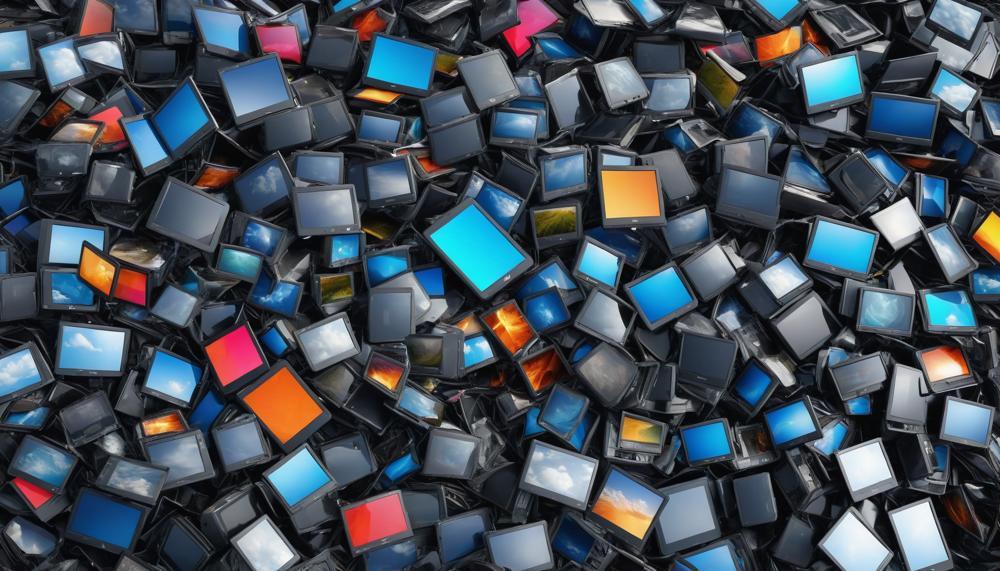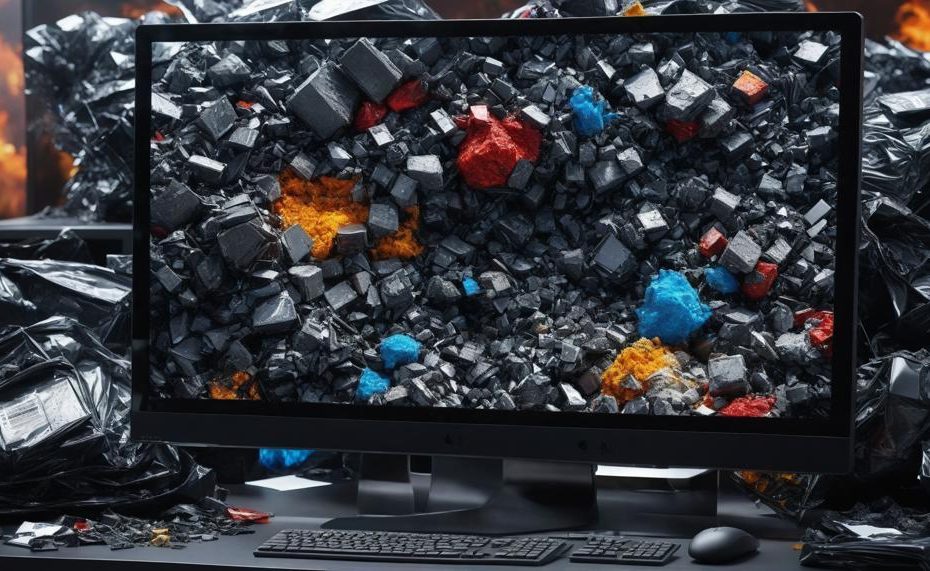Wondering how to dispose of that old computer monitor gathering dust in your closet? It’s not as simple as tossing it in the trash. Monitors contain hazardous materials that can wreak havoc on the environment if not handled properly. So, what’s the best way to get rid of them?
Yes, you should absolutely avoid throwing your monitor out with regular garbage. These devices are considered hazardous waste due to their toxic components like lead and mercury. Instead, the Environmental Protection Agency (EPA) recommends recycling or donating your old monitors. Many computer manufacturers and retailers have recycling programs designed to take this burden off your shoulders, often at no cost.
Proper disposal is not just about finding the right drop-off point. Cleaning the monitor and wiping any personal data are crucial steps to ensure your information stays safe and the environment remains uncontaminated. Plus, you might even find joy in knowing your old monitor could be refurbished and given a new life, rather than languishing in a landfill.
Here’s a quick summary of the key points:
- Avoid the Trash: Monitors are hazardous waste and should not be discarded with regular garbage.
- Recycle or Donate: Utilize recycling programs from manufacturers and retailers, or donate working monitors.
- Data Safety: Clean the monitor and remove personal data before disposal.
- Environmental Impact: Proper disposal helps protect the environment and human health.
Ready to learn more? Keep reading to discover detailed steps on how to properly dispose of your computer monitor and do your part in protecting our planet.
Contents
- 1 How To Dispose Of Computer Monitors Properly
- 2 Step 4: Look for Local Government Programs or Events
- 3 The Dangers of Improper Disposal
- 4 How to Recycle a Monitor Safely
- 5 Tips for Finding a Responsible Disposal Option
- 6 The Dangers of Improper Disposal
- 7 How to Recycle a Monitor Safely
- 8 Tips for Finding a Responsible Disposal Option
- 9 Conclusion
How To Dispose Of Computer Monitors Properly
Properly disposing of a computer monitor ensures environmental safety and prevents health hazards. Here’s how to do it right:
Check for Recycling Programs
Look for local recycling programs that accept electronic waste. Many cities have designated drop-off points or scheduled pickups for e-waste. These programs ensure monitors are recycled correctly, preventing harmful toxins from ending up in landfills.
| Resource | Details |
| Local Recycling Programs | Find information on your city or town’s official website. |
| EPA | Guidelines for electronics recycling and donation. |
Remove Personal Information
Ensure all personal information is erased from the monitor. This includes deleting files, clearing browsing history, and removing any external storage devices. Log out of all accounts linked to the device.
| Action | Details |
| File Deletion | Remove all personal files and documents. |
| Clear History | Clear browsing history and saved passwords. |
| Remove Storage Devices | Disconnect any USB drives or external hard drives. |
Prepare the Monitor for Transport
Pack the monitor securely to avoid damage during transportation. Use the original packaging if available, or a sturdy box with cushioning materials like bubble wrap or packing peanuts. Tape the box shut and label it as “fragile.”
| Step | Description |
| Use Original Packaging | If available, use the original monitor packaging for best fit. |
| Securely Pack | Use a sturdy box and ample cushioning to protect the monitor. |
| Label “Fragile” | Mark the box as “fragile” to alert handlers. |
Recycle at an Authorized Facility
Take the monitor to an authorized recycling facility. Ensure the facility is certified to handle electronic waste safely. Some facilities may provide a certificate of destruction or recycling.
| Facility | Details |
| Certified Recycler | Ensure the facility is certified and compliant with e-waste regulations. |
| Proof of Recycling | Some facilities offer certificates as proof of proper disposal. |
| e-Stewards | Locate certified e-waste recyclers. |
Avoid Dumping or Burning
Never dump or burn a computer monitor. This can release toxic chemicals into the environment and pose significant health risks. Illegal disposal can result in fines and other penalties.
| Action | Reason |
| Do Not Dump | Prevents hazardous materials from contaminating landfills. |
| Do Not Burn | Avoids releasing toxic chemicals into the air. |
| Legal Penalties | Improper disposal can result in fines and legal action. |
Step 4: Look for Local Government Programs or Events
Local governments offer various programs and events to help residents dispose of their computer monitors responsibly. Here are some examples:
| Program/Event | Description | Details |
| E-waste Collection Events | Designated days and locations for dropping off electronic waste | Local governments organise these events periodically. Check your city’s website or local bulletin for upcoming dates. Certified recycling companies handle the proper disposal of collected items. |
| Permanent E-waste Collection Centers | Facilities for year-round disposal of electronic waste | These centres are usually located at waste management facilities or specific drop-off sites. They offer a convenient option for disposing of e-waste anytime without waiting for special events. |
| Curbside Pick-up Services | Scheduled collection of e-waste from residents’ homes | Some local governments provide this service, allowing residents to schedule a pick-up for their old monitors. Items are collected separately from regular trash and taken to recycling facilities. |
| Incentive Programs | Programs offering rewards for proper e-waste disposal | These may include discounts on future waste management fees or vouchers for local businesses. Such incentives encourage residents to use designated disposal methods. |
| Electronic Waste Drives | Community events for e-waste collection | Often organised in collaboration with non-profits and private companies, these drives promote responsible e-waste disposal and raise awareness about its importance. |
The Dangers of Improper Disposal
The dangers of improper disposal of computer monitors are significant, posing threats to both environmental and human health. Here’s a detailed look at the potential hazards:
Environmental Contamination
Improperly disposing of computer monitors can lead to severe environmental contamination. Older models, especially those with cathode ray tubes (CRTs), contain hazardous substances like lead, mercury, and cadmium.
When these monitors end up in landfills, these toxic materials can leach into the soil, contaminating groundwater and harming plant and animal life.
Human Health Risks
Exposure to the toxic chemicals found in computer monitors can have dire health consequences.
Lead, for example, can cause neurological damage, especially in children. Mercury exposure can result in serious health issues, including kidney damage and impaired cognitive functions.
Cadmium is known to cause cancer and other serious illnesses.
Air Pollution
When computer monitors are incinerated, they release harmful chemicals into the air.
Burning plastics and other materials used in monitors can produce dioxins and furans, which are highly toxic and can cause respiratory problems, skin issues, and other health problems.
Resource Waste
Improper disposal of computer monitors also represents a significant waste of valuable resources. Monitors contain metals and other materials that can be recycled and reused.
By not properly recycling these components, we miss the opportunity to conserve natural resources and reduce the environmental impact of manufacturing new products.
Legal and Economic Consequences
Improper disposal of e-waste can lead to legal consequences, as many regions have stringent regulations regarding e-waste disposal. Fines and other penalties can be imposed on individuals and businesses that fail to comply with these laws.
Additionally, the costs associated with cleaning up contaminated sites and addressing public health issues can be substantial.
Hazardous Substances in Computer Monitors
| Substance | Health Risks | Environmental Impact |
| Lead | Neurological damage, especially in children | Soil and water contamination |
| Mercury | Kidney damage, cognitive impairment | Water contamination, bioaccumulation in the food chain |
| Cadmium | Cancer, respiratory issues | Soil and water contamination, long-term persistence in the environment |
For more information on the proper disposal of computer monitors, refer to your local government resources or visit reputable sites like EPA’s e-waste management.
How to Recycle a Monitor Safely
Prepare Your Monitor
Unplug and dust off your monitor. Cleaning it ensures safety for handlers and facilitates proper recycling.
Consider Repair or Resale

Assess if the monitor is still functional. Repairing or selling it can extend its life and reduce electronic waste.
Check Manufacturer Recycling Programs
Many manufacturers offer recycling services. Contact your monitor’s manufacturer to inquire about their program. For example, Dell’s Recycling Program.
Locate E-Waste Recycling Facilities
Find a local e-waste recycling provider. Use resources like Earth911 to locate nearby facilities.
Prepare for Drop-off or Pick-up
Ensure your monitor is securely packaged if you are dropping it off or arranging for a pick-up. This step protects the monitor from damage during transit.
Erase Personal Data
Remove any data stored in your monitor, if applicable. This step is crucial for protecting your personal information.
Tips for Finding a Responsible Disposal Option
| Tip | Explanation | Action |
| Check with the Manufacturer | Many manufacturers offer recycling or trade-in programs for old monitors. This can ensure proper disposal and might provide discounts on new purchases. | Dell Recycling Program |
| Research Local Recycling Options | Local waste management services often have designated e-waste recycling centers or host events to collect electronics responsibly. | Earth911 Recycling Search |
| Look for Certified E-Waste Recyclers | Ensure recyclers are certified by organizations like R2 or e-Stewards, which adhere to strict environmental and ethical standards. | Find R2 Certified Recyclers |
| Consider Donating | If the monitor is still functional, donate it to schools, charities, or community centers, which can benefit from it. | TechSoup Donation Programs |
| Participate in Trade-In Programs | Some retailers and manufacturers offer trade-in programs, allowing you to exchange old monitors for discounts on new products. | Apple Trade-In Program |
| Properly Erase Data | Ensure all personal data is wiped from the monitor before disposal. Use data wiping software or physically destroy the hard drive to prevent data recovery. | DBAN Data Erasure Software |
| Avoid Landfills | Never dispose of monitors in landfills. They contain harmful materials like lead and mercury, which can cause environmental damage. | Use certified recyclers or donation programs to avoid landfill disposal. |
By following these steps, you can responsibly dispose of your computer monitor while protecting the environment and potentially benefiting others.
The Dangers of Improper Disposal
The potential hazards of not disposing of computer monitors properly are significant, affecting both the environment and human health. Here’s what you need to know:
| Hazard | Description | Impact |
| Environmental Harm | Monitors contain hazardous materials like lead and mercury | Pollutes soil and water, harms ecosystems |
| Health Risks | Exposure to toxic substances | Cognitive impairments, nervous system damage |
| Improper Handling | Releasing toxic materials when broken | Health hazards from exposure |
| Landfill Pollution | Monitors in landfills release toxins | Long-term soil and water contamination |
| Lack of Responsible Practices | Improper disposal supports bad waste management | Undermines environmental sustainability |
How to Recycle a Monitor Safely
| Step | Description | Links/Resources |
| Unplug and Clean | Disconnect the monitor and clean it. | |
| Check for Reusability | Consider selling or donating if functional. | |
| Remove Accessories | Remove cables and peripherals for reuse or separate recycling. | |
| Manufacturer Programs | Use take-back programs from manufacturers like Dell, HP, or Apple. | Apple Recycling |
| Retailer Services | Stores like Best Buy and Staples offer free recycling services. | Best Buy Recycling |
| Local E-Waste Services | Find local recycling facilities through state websites or EPA. | EPA Electronics Recycling |
| EPR Programs | Check if your device qualifies for EPR programs for trade-in or recycling. | |
| Environmental Considerations | Proper disposal is crucial to avoid environmental harm. | |
| Professional Services | Businesses can use professional e-waste services for bulk disposal. | RTS E-Waste Services |
Tips for Finding a Responsible Disposal Option
Check with Local Recycling Facilities
- Contact your city’s recycling centers to see if they accept e-waste like computer monitors.
- Many centers have the technology to safely handle hazardous materials such as lead and mercury.
Manufacturer Take-Back Programs
- Investigate if the computer monitor’s manufacturer offers a take-back program.
- Companies like Dell, HP, and Apple provide recycling services, ensuring eco-friendly disposal.
Community E-Waste Events
- Look out for local e-waste collection events.
- These events are often held annually and provide a safe place to drop off old monitors.
Donate or Sell Working Monitors
- If your monitor is still functional, consider donating it to a non-profit or school.
- Alternatively, sell it to a second-hand store or online marketplace.
Professional Disposal Services
- Hire a certified e-waste disposal service if local options are unavailable.
- These services specialize in handling and disposing of hazardous electronic waste properly.
Retailer Recycling Programs
- Some retailers like Best Buy offer free recycling for electronics, including computer monitors.
- Check their website or contact customer service for details.
Clean and Prepare Your Monitor
- Before disposing of your monitor, wipe any personal data and clean the exterior.
- This ensures data security and prevents contamination during recycling.
Conclusion
Disposing of an old computer monitor responsibly is essential for safeguarding both the environment and human health. Monitors, often considered hazardous waste, contain toxic materials like lead and mercury, which can cause significant harm if not handled properly. Therefore, it’s imperative to avoid simply throwing them in the trash.
The best way to dispose of a monitor is through recycling or donating. Many computer manufacturers and retailers offer convenient recycling programs, often free of charge, ensuring that these devices are processed correctly. Additionally, donating a functioning monitor can give it a second life, benefiting someone in need while keeping it out of landfills.
Before recycling or donating, ensure that all personal data is wiped from the monitor to protect your privacy. Securely packing the monitor for transport is also crucial to prevent any damage during handling.
Proper disposal practices extend beyond individual actions. Utilizing local government e-waste programs, attending e-waste collection events, or dropping off monitors at designated facilities ensures that hazardous components are managed safely. This collective effort not only mitigates environmental contamination but also conserves valuable resources by enabling the recycling of metals and other materials found in monitors.





